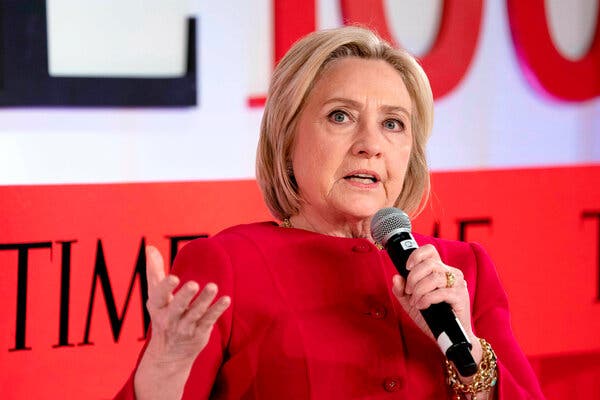Advertisement
Democrats have been far behind Republicans on compiling and sharing information that can be used by campaigns, state parties and super PACs.

WASHINGTON — When Hillary Clinton lost the 2016 election, she blamed Russian interference and the former F.B.I. director James Comey’s eleventh-hour resurrection of her emails for her defeat.
But she also lashed out at something that got far fewer headlines: the Democratic National Committee’s failure to keep up with Republicans in the data arms race.
Now, with less than two months remaining before the 2020 election, the party has started the Democratic Data Exchange, a legally independent entity that allows campaigns, state parties, super PACs and other independent groups that are forbidden to coordinate with each other to share information on individual voters.
Democratic officials involved in the new data program say the system will help them narrow what had been a yawning gap between their party and Republicans, who started a similar independent data operation ahead of the 2016 election. Campaigns and supportive independent groups will now have a full, and nearly real-time, view into which voters have been contacted by other Democratic organizations and how those voters feel about candidates.
Access to that information can be critical, particularly in battleground states, where the contest between President Trump and former Vice President Joseph R. Biden Jr. is expected to be close. In Michigan, Pennsylvania and Wisconsin — the three states that swung the 2016 election to Mr. Trump — the president won by a total of just 77,000 votes.
Along with the 50 state parties and the Democratic National Committee, the exchange includes several dozen Democratic outside groups and super PACs, including Priorities USA, Senate Majority PAC, House Majority PAC, Emily’s List, major labor and environmental organizations and Everytown for Gun Safety, the gun-control group that is largely funded by Michael R. Bloomberg.
The Democratic National Committee chairman, Tom Perez, spent much of 2018 quietly cajoling his party’s state chairmen, who were reluctant to relinquish control of their data to a clearinghouse outside the control of the national committee, to sign on to the exchange. He and others argued that an independent data agency was necessary if the party hoped to begin narrowing the Republicans’ voter data advantage.
“I mean, I walked into a Radio Shack, and that was a challenge,” Mr. Perez said of the party’s data operation upon his arrival as chairman. “We really needed to get into the — not just the 21st century, but the mid-21st century.”
Mrs. Clinton, following her 2016 defeat, was particularly focused on the data gap between Democrats and Republicans. In March 2017, just weeks after he had won election to become party chairman, Mr. Perez visited Mrs. Clinton in her Chappaqua, N.Y., home and received a briefing about what her plans to rebuild the party’s data infrastructure would have been.
That July, Mrs. Clinton publicly criticized the data she had received from the party while running for president as “mediocre to poor, nonexistent, wrong.” Clinton campaign veterans still privately seethe at President Barack Obama’s aides for allowing the D.N.C. to atrophy during his second term, leaving her campaign at a substantial disadvantage.
The election of “2016 was the ultimate moment of frustration because you have more and more resources going into these elections, and the entire progressive Democratic ecosystem was not on the same page,” said Stephanie Schriock, the president of Emily’s List, an organization that backs Democratic women running for office.
A demonstration of the Democratic Data Exchange conducted last week for The New York Times showed a dashboard that allows campaigns, state parties and independent organizations to sort voters based on categories including whom they support for a particular office — from president to state legislative seats and local offices — and what their comfort level is with voting by mail and whether they trust the Postal Service.
While campaign officials have long had access to that sort of information, Democrats have never before been able to share it across the party’s archipelago of allied groups. And in a year in which Democratic campaigns are eschewing door-knocking amid the coronavirus pandemic, information on individual voters views is a valuable commodity.
“The thing that is most predictive of if you’re going to vote in this election or vote for this candidate,” said Lindsey Schuh Cortes, the exchange’s chief executive, “is voter contact data where you’re literally asking somebody: ‘Do you support this candidate? Are you going to turn out to vote?’ This data is really helpful at the tactical level to figure out: ‘Who am I contacting? Who am I not contacting?”
Ms. Schuh Cortes said Democratic campaigns and organizations would also use the exchange to conserve their resources.
“If you were going to send the 900th text message to somebody, you probably don’t have to send that 900th text message,” she said. “The other 899 probably did the job.”
The exchange has gone live in 13 states — 11 presidential battlegrounds, plus Colorado and Missouri — and expects to be online in 10 more states, which include many of those with competitive Senate races, by the end of this week.
It works like a cooperative. State parties and the outside groups involved have each paid a membership fee, but to receive more data from the exchange, they must first input their own information about voters.
While the system is built for advancing Democrats in general elections, it may be useful — and create tensions — in future primary contests. Many of the Democratic organizations involved in the exchange are major players in Democratic primaries for House and Senate seats, and most Democratic state parties take vows of neutrality in intraparty contests.
Democratic officials said that each organization that added its data into the exchange would be allowed to determine whether its specific information could be used in both primaries and general elections or be limited only to general elections.
Democrats already have evidence of how crucial the data can be. When party officials did a test run of their system last year for the Kentucky governor’s race, three weeks before the election, the data exchange produced a list of 14,483 voters who supported Andy Beshear, the Democratic candidate, that the Kentucky Democratic Party did not already have in its own voter database.
The party went on to contact them all, said Mary Nishimuta, the executive director of the Kentucky Democrats, and 9,587 of them voted. Mr. Beshear won the election by 5,086 votes.
That sort of information had been available to Republicans but not to Mrs. Clinton in 2016. Adhering to Federal Election Commission rules barring coordination between candidates and independent expenditure groups, Mrs. Clinton’s top aides were unaware of what supportive organizations were doing on her behalf and were unable to calibrate their decisions and strategy based on what others had learned about voters.
“I remember in 2016 going to a post-mortem meeting with a bunch of allied groups and them listing off everything they were doing, and I didn’t know any of it,” Robby Mook, Mrs. Clinton’s campaign manager, said in an interview last week.
The Biden campaign and its top allies will use the exchange not just to find information about specific voters but to determine what types of voters other supportive groups are targeting — information that can guide decisions on how to avoid duplication of outreach efforts.
“You had independent groups and the Clinton campaign doing voter registration, often in same location at the same time,” said Guy Cecil, the chairman of Priorities USA, the largest Democratic super PAC. “We had people knocking on the same doors and making phone calls to the same households.”
Updated Sept. 6, 2020
-
The Latest
-
President Trump has reached Labor Day weekend — the traditional kickoff of the fall campaign — as the biggest underdog incumbent since George Bush in 1992.
-
-
How to Win 270
-
Voting by Mail
-
Will you have enough time to vote by mail in your state? Yes, but it’s risky to procrastinate. Check your state’s deadline.
-
-
Keep Up With Our Coverage





